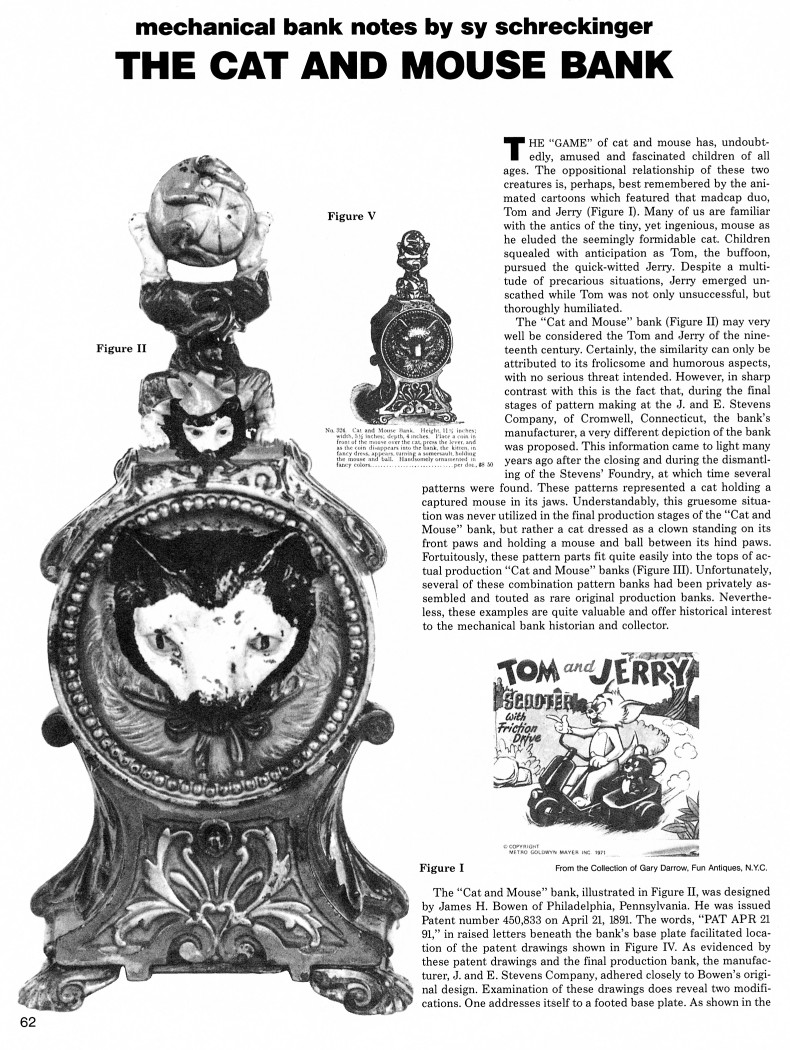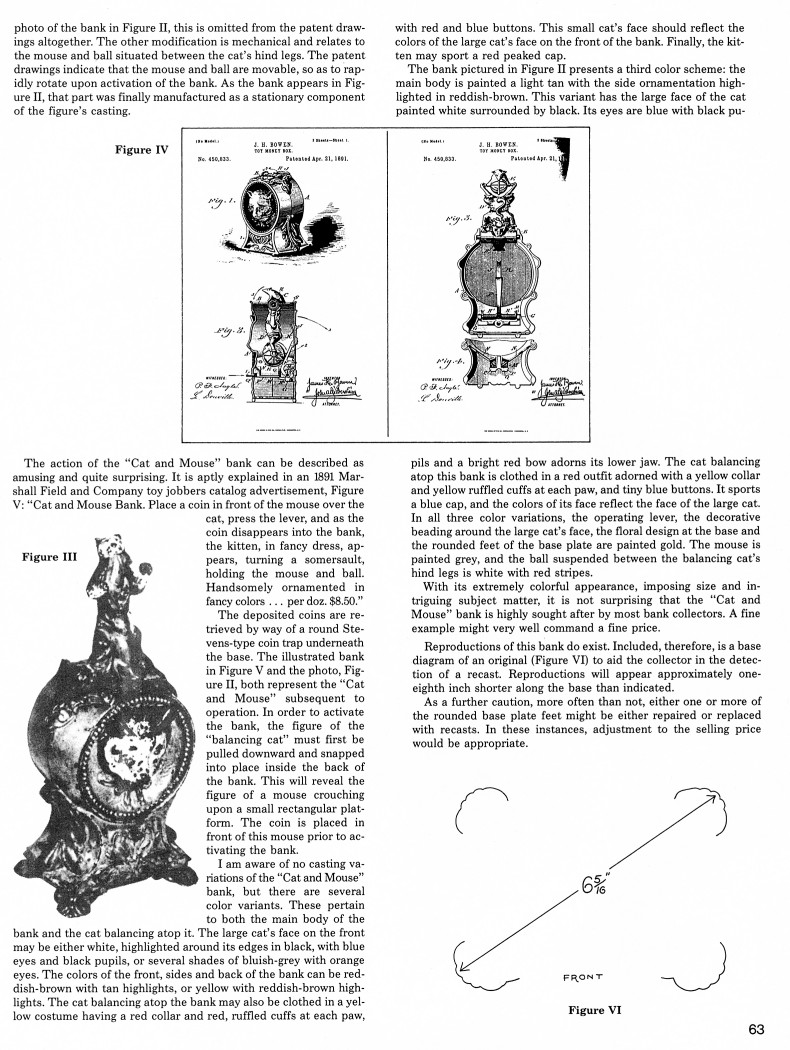|
The Cat and Mouse Bank
by Sy Schreckinger – ANTIQUE TOY WORLD Magazine – September, 1989
The "GAME" of cat
and mouse has, undoubtedly, amused and fascinated children of all ages.
The oppositional relationship of these two creatures is, perhaps, best
remembered by the animated cartoons which featured that madcap duo, Tom
and Jerry (Figure I). Many of us are familiar with the antics of the tiny,
yet ingenious, mouse as he eluded the seemingly formidable cat. Children
squealed with anticipation as Tom, the buffoon, pursued the quick-witted
Jerry. Despite a multitude of precarious situations, Jerry emerged
unscathed while Tom was not only unsuccessful, but thoroughly humiliated.
The "Cat and Mouse" bank (Figure II) may very well be considered the
Tom and Jerry of the nineteenth century. Certainly, the similarity can
only be attributed to its frolicsome and humorous aspects, with no serious
threat intended. However, in sharp contrast with this is the fact that,
during the final stages of pattern making at the J. and E. Stevens
Company, of Cromwell, Connecticut, the bank's manufacturer, a very
different depiction of the bank was proposed. This information came to
light many years ago after the closing and during the dismantling of the
Stevens' Foundry, at which time several patterns were found. These
patterns represented a cat holding a captured mouse in its jaws.
Understandably, this gruesome situation was never utilized in the final
production stages of the "Cat and Mouse" bank, but rather a cat dressed as
a clown standing on its front paws and holding a mouse and ball between
its hind paws. Fortuitously, these pattern parts fit quite easily into the
tops of actual production "Cat and Mouse" banks (Figure III).
Unfortunately, several of these combination pattern banks had been
privately assembled and touted as rare original production banks.
Nevertheless, these examples are quite valuable and offer historical
interest to the mechanical bank historian and collector.
The "Cat and Mouse" bank, illustrated in Figure II, was designed by
James H. Bowen of Philadelphia, Pennsylvania. He was issued Patent number
450,833 on April 21, 1891. The words, "PAT APR 21 91," in raised letters
beneath the bank's base plate facilitated location of the patent drawings
shown in Figure IV. As evidenced by these patent drawings and the final
production bank, the manufacturer, J. and E. Stevens Company, adhered
closely to Bowen's original design. Examination of these drawings does
reveal two modifications. One addresses itself to a footed base plate. As
shown in the photo of the bank in Figure II, this is omitted from the
patent drawings altogether. The other modification is mechanical and
relates to the mouse and ball situated between the cat's hind legs. The
patent drawings indicate that the mouse and ball are movable, so as to
rapidly rotate upon activation of the bank. As the bank appears in Figure
II, that part was finally manufactured as a stationary component of the
figure's casting.
The action of the "Cat and Mouse" bank can be described as amusing
and quite surprising. It is aptly explained in an 1891 Marshall Field and
Company toy jobbers catalog advertisement, Figure V: "Cat and Mouse Bank.
Place a coin in front of the mouse over the cat, press the lever, and as
the coin disappears into the bank, the kitten, in fancy dress, appears,
turning a somersault, holding the mouse and ball. Handsomely ornamented in
fancy colors ... per doz. $8.50."
The deposited coins are retrieved by way of a round Stevens-type coin
trap underneath the base. The illustrated bank in Figure V and the photo,
Figure II, both represent the "Cat and Mouse" subsequent to operation. In
order to activate the bank, the figure of the "balancing cat" must first
be pulled downward and snapped into place inside the back of the bank.
This will reveal the figure of a mouse crouching upon a small rectangular
platform. The coin is placed in front of this mouse prior to activating
the bank.
I am aware of no casting variations of the "Cat and Mouse" bank, but
there are several color variants. These pertain to both the main body of
the bank and the cat balancing atop it. The large cat's face on the front
may be either white, highlighted around its edges in black, with blue eyes
and black pupils, or several shades of bluish-grey with orange eyes. The
colors of the front, sides and back of the bank can be reddish-brown with
tan highlights, or yellow with reddish-brown highlights. The cat balancing
atop the bank may also be clothed in a yellow costume having a red collar
and red, ruffled cuffs at each paw, with red and blue buttons. This small
cat's face should reflect the colors of the large cat's face on the front
of the bank. Finally, the kitten may sport a red peaked cap.
The bank pictured in Figure II presents a third color scheme: the
main body is painted a light tan with the side ornamentation highlighted
in reddish-brown. This variant has the large face of the cat painted white
surrounded by black. Its eyes are blue with black pupils and a bright red
bow adorns its lower jaw. The cat balancing atop this bank is clothed in a
red outfit adorned with a yellow collar and yellow ruffled cuffs at each
paw, and tiny blue buttons. It sports a blue cap, and the colors of its
face reflect the face of the large cat. In all three color variations, the
operating lever, the decorative beading around the large cat's face, the
floral design at the base and the rounded feet of the base plate are
painted gold. The mouse is painted grey, and the ball suspended between
the balancing cat's hind legs is white with red stripes.
With its extremely colorful appearance, imposing size and intriguing
subject matter, it is not surprising that the "Cat and Mouse" bank is
highly sought after by most bank collectors. A fine example might very
well command a fine price.
Reproductions of this bank do exist. Included, therefore, is a base
diagram of an original (Figure VI) to aid the collector in the detection
of a recast. Reproductions will appear approximately one-eighth inch
shorter along the base than indicated.
As a further caution, more often than not, either one or more of the
rounded base plate feet might be either repaired or replaced with recasts.
In these instances, adjustment to the selling price would be appropriate.
|


